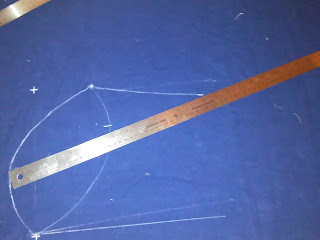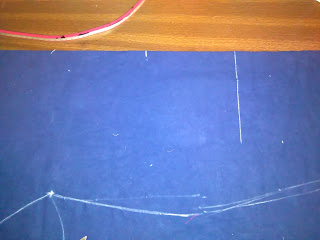And it's time for Part Two of Three on the making of my Banyan, based on an example from the 1760s in the Los Angeles County Museum of Art. As you might guess by the title, the majority of this post is on drafting the sleeves--the cuffs and collar are both quite simple.
For a recap, this particular garment is based on the one the LACMA provided a lovely pattern and information on. However, while they provided a pattern, they do not tell you how to draft the garment so it fits you (their scaling grid is also terrible).
The way I do sleeves is fairly simple; essentially you take the measurements of the armscye, and transfer those to your sleevehead. However, a word of warning that some parts of sleeve drafting--the hang of the arm in particular--are rather complicated, and something you will have to learn on your own (until I get good enough that I can explain it); when it comes to the lateral rotation (as swinging your arms normally) you want the top and bottom of the sleevehead to be in line with the natural hang of your arm. As such, it may not hurt to mark the low point while the body is on your victim as well.
If you made it to this article without reading Part 1, it may be found HERE.
Start out by marking the desired location of your hindarm seam. In this case, I chose about halfway down the back armscye, which is fairly typical.
Likewise, you need to mark the location of the front seam. This should be a couple inches above the bottom of the scye.
Thirdly, find and mark the lowest point of the armscye. Here, it is a bit further back than it probably should be.
You also need to find the highest point (which must be done while the body is being worn), and mark that as well. It should not be in the same spot as the shoulder seam, assuming you drafted by my instructions earlier. I chose to use pins, since they neither can be rubbed out from handling, nor have to be rubbed out later.
Now, you will start measuring. Take your flexible tape, starting at the rearmost pin (hindarm seam), and begin following the armscye. It is important that you do not measure at the outer edge; if you do, the length will be wrong. Rather, use the inside edge of the tape, to simulate the seam allowance.
The first measurement you mark down will be from the hindarm seam, to the top.
Continue measuring to the forearm seam. In the end, you may need to adjust the location of this, and that will be okay.
And keep going all the way around, marking down the measurement at every mark.
In the end, you should have something that looks like this:
The high point is 5" from the hindarm seam. The front seam is 13.25 from the hindarm; low point is 19.75"; and the total circumference is 25.5"
Other measurements you need are
Arm length (from the point of the shoulder, and over your bent elbow) and same to the tip of the elbow
Elbow Circumference (fully bent)
Now for the actual drafting. Start out by marking your sleeve width. As a general rule, 18th century coatsleeves are fairly narrow; however, I haven't chewed through the data to find the exact correlation (assuming there is one) between scye circumference and sleeve width. Suffice it to say that you want it as narrow as you can, while fitting the scye circumference in there, and keeping the head as shallow as possible as well.
In this case, I divided my scye measure in half, then used 3/4ths of the result (9.75")
On the far side, measure down by about 4" and make a mark (Spot 3). This is decidedly malleable, but is what allows you to fit measurement of the sleevehead in a narrower sleeve.
Take a measuring...device--I used a lead filled flexi-ruler (highly recommended), but a measuring tape would work fine, as would a marked string if that's all you have.
You want to anchor the end at the first mark, line the measure to the forearm seam up with Spot 3. Curve the ruler to put the correct measure for the high point (5" for me) at the top of the curve.
You then want to do the same for the undersleeve, with the measurement for the low point measured from Spot 3.
Sorry about the poor photo...you can see what you need, at least. With the sleevehead drafted, it's time for the hindarm seam. Nice and simple... You need to measure down to the elbow measurement, keeping the line on grain (although angling it in slightly is also acceptable).
Almost time for the fun part I found. But first, you need to square across by your half elbow measure, plus 1-2" of ease. Connect this to the end of the sleeve cap.
And here we go: Something I found first time I drafted this, then double checked in Waugh, I noticed something interesting; the angle of the forearm is roughly parallel to the angle between the high and low points of the sleevecap. So, line up your rule (24" or longer) like above and sketch a line.
Now, extend the hindarm seam to follow the forearm seam you jotted above to make the sleeve full length (or the correct length for the style). Square the cuff across; I went with 6"...you will do so to taste.
After that, hollow the forearm seam smoothly, making the deepest part slightly above the elbow.
Now for the other bits; while they are both quite simple, I figured I would cover them anyways.
The cuff on the banyan is simple, more or less a tube made slightly larger than the sleeve.
Interestingly, the inside (on the fold) appears to be higher than the outside (hindarm).
The collar is roughly the same--just a simple, slightly curved strip the length of the neckline and cut on the fold. It could range from 1/2" at the center back and tapering to nothing at center front, to a couple inches wide.
As you see, I made mine slightly wider, although I may change this.
That's it, folks. Not actually that difficult.
Bibliography:
LACMA. 1760s Robe at Home. http://www.lacma.org/sites/default/files/FF_patterns_mansrobe_0.pdf
Waugh, Nora. Cut of Men's Cloths, 1600-1900. 1964. PDF.
© John
Frey, 2016. The Author of this work retains full copyright for this material.
Permission is granted to make and distribute verbatim copies of this document
for non-commercial private research or educational purposes provided the
copyright notice and this permission notice are preserved on all copies.



















No comments:
Post a Comment